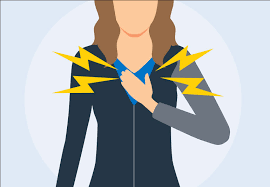Understanding Chest Pain: Not All Pain Is Equal

Chest pain can range from mild to severe and present in various forms—sharp, dull, burning, squeezing, or stabbing. The nature of the pain often provides crucial clues about its underlying cause.
Common Types of Chest Pain:
-
Cardiac (Heart-Related)
Often described as pressure, tightness, or heaviness in the chest, this pain may spread to the arms, neck, jaw, or back. It typically lasts more than a few minutes and may be triggered by physical exertion or emotional stress. -
Gastrointestinal
Burning pain behind the breastbone could be due to acid reflux or heartburn. This pain may worsen after eating or when lying down. -
Musculoskeletal
Pain that worsens with movement, stretching, or pressing on the chest wall is often related to muscle strain or inflammation (costochondritis). -
Pulmonary (Lung-Related)
Sharp pain during breathing or coughing could point to pleurisy, pneumonia, or even a pulmonary embolism. -
Psychological
Panic attacks or extreme anxiety can produce intense chest discomfort, often accompanied by a racing heart, sweating, and a sense of doom.
Red Flags: When to Seek Emergency Help
No matter the cause, there are certain symptoms that should never be ignored. Call emergency services immediately if chest pain is accompanied by:
-
Shortness of breath
-
Sweating or cold sweats
-
Dizziness or fainting
-
Nausea or vomiting
-
Pain radiating to the jaw, arm, or back
-
Fast or irregular heartbeat
-
Loss of consciousness
If you're unsure whether your symptoms are serious, it's always better to be cautious and seek medical attention.
Important Questions to Ask Yourself
To better evaluate chest pain, consider the following:
-
When did the pain start? Sudden onset may suggest a more serious issue.
-
What does it feel like? Pressure or squeezing may indicate heart-related causes, while sharp pain may be more muscular or lung-related.
-
Where is it located? Central chest pain may be cardiac; pain localized to one spot may be muscular.
-
Does it radiate? Pain that spreads to other parts of the body can be a sign of a heart issue.
-
What were you doing when it started? If it came on during physical activity, a cardiac cause is more likely.
-
What makes it better or worse? Heart-related pain usually doesn't improve with movement or rest.
Diagnostic Tools Used by Doctors
When you go to the doctor, they may perform several tests to determine the source of your chest pain:
-
Electrocardiogram (ECG) to check heart rhythms
-
Chest X-ray to examine lungs and bones
-
Blood tests to detect heart damage
-
CT scan or MRI for a detailed internal view
-
Stress test to observe heart function under physical exertion
Never rely on self-diagnosis or over-the-counter solutions without professional guidance. For example, using medications like filagra professional for performance or circulation-related concerns should only be done under medical supervision, especially when chest discomfort is involved.
Preventive Tips for a Healthy Chest and Heart
-
Quit smoking and limit alcohol intake
-
Exercise regularly to improve cardiovascular and respiratory health
-
Maintain a balanced diet to reduce cholesterol and blood pressure
-
Manage stress and anxiety with mindfulness or therapy
-
Stay up to date with regular health checkups and screenings
Final Thoughts
Chest pain should never be taken lightly. While it might be caused by something minor, it can also be the only warning sign of a major medical event. Knowing how to evaluate your symptoms and act quickly is essential for your well-being.
When in doubt, always seek professional medical help. Early detection and response are often the key to better outcomes.
- Art
- Causes
- Crafts
- Dance
- Drinks
- Film
- Fitness
- Food
- Игры
- Gardening
- Health
- Главная
- Literature
- Music
- Networking
- Другое
- Party
- Religion
- Shopping
- Sports
- Theater
- Wellness


